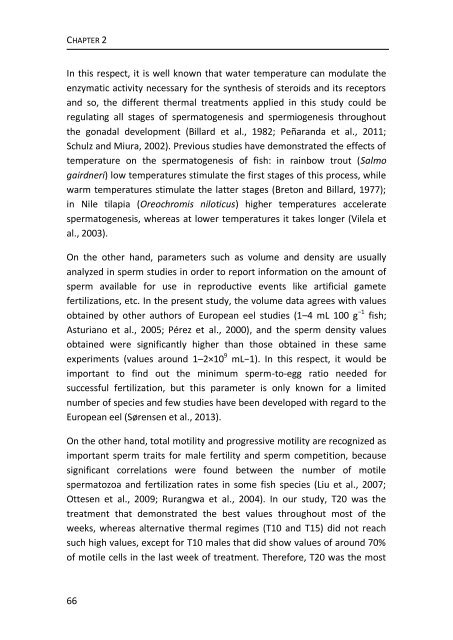chapter 3 - RiuNet
chapter 3 - RiuNet
chapter 3 - RiuNet
Create successful ePaper yourself
Turn your PDF publications into a flip-book with our unique Google optimized e-Paper software.
CHAPTER 2<br />
In this respect, it is well known that water temperature can modulate the<br />
enzymatic activity necessary for the synthesis of steroids and its receptors<br />
and so, the different thermal treatments applied in this study could be<br />
regulating all stages of spermatogenesis and spermiogenesis throughout<br />
the gonadal development (Billard et al., 1982; Peñaranda et al., 2011;<br />
Schulz and Miura, 2002). Previous studies have demonstrated the effects of<br />
temperature on the spermatogenesis of fish: in rainbow trout (Salmo<br />
gairdneri) low temperatures stimulate the first stages of this process, while<br />
warm temperatures stimulate the latter stages (Breton and Billard, 1977);<br />
in Nile tilapia (Oreochromis niloticus) higher temperatures accelerate<br />
spermatogenesis, whereas at lower temperatures it takes longer (Vilela et<br />
al., 2003).<br />
On the other hand, parameters such as volume and density are usually<br />
analyzed in sperm studies in order to report information on the amount of<br />
sperm available for use in reproductive events like artificial gamete<br />
fertilizations, etc. In the present study, the volume data agrees with values<br />
obtained by other authors of European eel studies (1–4 mL 100 g −1 fish;<br />
Asturiano et al., 2005; Pérez et al., 2000), and the sperm density values<br />
obtained were significantly higher than those obtained in these same<br />
experiments (values around 1–2×10 9 mL−1). In this respect, it would be<br />
important to find out the minimum sperm-to-egg ratio needed for<br />
successful fertilization, but this parameter is only known for a limited<br />
number of species and few studies have been developed with regard to the<br />
European eel (Sørensen et al., 2013).<br />
On the other hand, total motility and progressive motility are recognized as<br />
important sperm traits for male fertility and sperm competition, because<br />
significant correlations were found between the number of motile<br />
spermatozoa and fertilization rates in some fish species (Liu et al., 2007;<br />
Ottesen et al., 2009; Rurangwa et al., 2004). In our study, T20 was the<br />
treatment that demonstrated the best values throughout most of the<br />
weeks, whereas alternative thermal regimes (T10 and T15) did not reach<br />
such high values, except for T10 males that did show values of around 70%<br />
of motile cells in the last week of treatment. Therefore, T20 was the most<br />
66
















